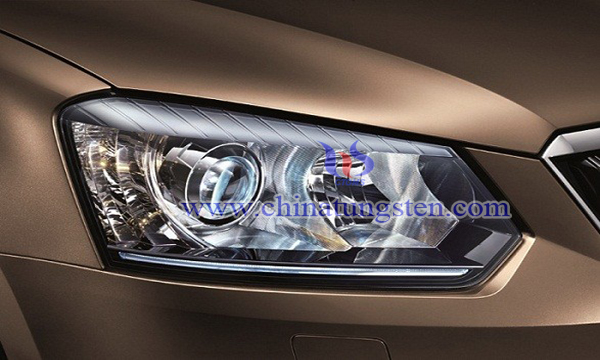The Improvement Strategy of Tungsten Wire of Halogen Lamps
- Details
- Category: Tungsten Information
- Published on Monday, 05 February 2018 17:09
Halogen lamps are mainly used in the automotive industry, electronics industry and aerospace lighting industry. Due to the impact and vibration characteristics of the application environment, halogen lamps requires its core material — the recrystallization of tungsten wire forming a good dovetail lap structure, with its length-width ratio larger than 12 , that is high intensity under the state of high temperature ignition point, good sag resistance performance at high temperature and good anti-deformation performance.

Tungsten wire production process is long. Besides, when the transition from the powder state to the sintered state (tungsten bar) process completed, the chemical composition and the organizational performance of tungsten wire has been established. And it means that the subsequent rolling processes have a little impact on the amendment and improvement of the sag resistance performance at high temperature of tungsten wire. Therefore, how to obtain a high-K tungsten strip with a well-organized structure has become the key point for improving the quality of tungsten wire for halogen lamps.
Improving the quality of tungsten wire preparation, starting from improving the manufacturing process, some scholars provide a method for the production of the tungsten wire of the halogen lamps’ preparation. Using this method of preparation we can get that the potassium content of tungsten Rod is more than 0.0085%, with the density more than 17.20g/cm3 and grain size more than 6000 / mm2.The existing conventional technology for pressure processing, can produce recrystallized structure that presents good dovetail lap, with length-width ratio larger than 12, stable quality, high production yield, high intensity under the state of high temperature ignition point, good sag resistance performance at high temperature and good anti-deformation performance. The main steps are as follows:
1. Picking materials. Mix monoclinic ammonium paratungstate with spherical ammonium paratungstate at the ratio of 3: 1 ~ 1.5 and get the mixture as raw material.
2. Pre-Reduction. Using conventional technique, pass the above raw materials through a four zone temperature reduction furnace, and the hydrogen is reduced to generate blue tungsten oxide containing 20 to 20.5% of oxygen.
3. Dope with high-potassium. Use conventional method and add potassium silicate and aluminum nitrate solution into blue tungsten oxide with hydrometallurgy to make potassium, silicon, aluminum adsorbed in the blue tungsten pore. The doped blue tungsten contains potassium, silicon and aluminum which are 0.18 ~ 0.20%, 0.30 ~ 0.35% and 0.010 ~ 0.013% respectively.
4. Reduction. Use conventional reduction process twice to make the doped blue tungsten generate Fischer-Tropsch particle size to coarse, medium and fine particles of tungsten powder. In the first reduction, the temperature of making tungsten dioxide with doped blue tungsten is 530℃,550℃,580℃,620℃,650℃ and 670℃; flow rate of hydrogen is 2.0~3.0m3/h;the dew point of hydrogen is equal to or less than ‑60℃; Pushing speed is at 25min / boat; the oxygen content of the tungsten oxide is 12-14%. In the second reduction, the processing condition of making grain tungsten powder is 700℃, 750℃, 800℃, 830℃, 860 ℃and 860℃;Low rate of hydrogen is 3.0~5.0m3/h; the dew point of hydrogen is equal to or less than ‑60℃; loading capacity is 280~320g/boat; Pushing speed is at 30min / boat.
5. Acid-pickling. Remove excess dopants and impurities in the fine, medium and coarse particles of tungsten powder with a concentration of 5 to 6% hydrochloric acid and 5 to 6% hydrofluoric acid respectively. Then get the acid-pickling tungsten powder in which the effective potassium is 0.016 to 0.018%, 0.012 to 0.014% and 0.008 to 0.010% respectively.
6. Flour blending. Blend the fine, medium and coarse particle pickling tungsten powder according to the weight ratio of 20 ~ 25, 60 ~ 50 and 20 ~ 25 in the blender for about 25 ~ 30min.
7. Cold isostatic. Put 2000g tungsten powder into a diameter of 23 ± 0.2mm elastic die set with conventional technology, and shape them by the cold isostatic compaction machine with the maximum pressing pressure of 150 ~ 160MPa. Under the protection of hydrogen, the shaped tungsten billets can be pre-sintered at 1300±50℃ 40 ~ 45 min.
8. Sinter at high temperature. Under the protection of hydrogen, heat and sinter the tungsten billet after pre-sintering in the vertical melting machine directly; The sintering system is three sections of heating and two sections of insulation; Current/time parameters for heating is (0‑2000A)/5min and (2000‑3800A)/15min; Keep the temperature for 3800A/15min; Increase the temperature for (3800‑4900A)/2min; Keep the temperature for 4900A/20min. The section of output tungsten strip is small and uniform crystalline, with potassium content ≥ 0.0085%, density ≥ 17.20g / cm3 and grain size ≥ 6000 / mm2.
The differences from the conventional process are that preparing the raw material by mixing two kinds of ammonium paratungstate crystals, doping with high potassium, adding one kind of medium-grain tungsten powder and adopting the unique vertical melting temperature sintering system. The medium-sized tungsten powder optimizes the powdering plan, after the cooperation, the particle size distribution of tungsten powder avoid the phenomenon of spikes or bimodal, presenting a good normal distribution. After high temperature sintering, the section of tungsten crystal is small and uniform. All of this can eventually make the tungsten wire of the halogen lamps has all the best performance.
- Tungsten Manufacturer & Supplier, Chinatungsten Online: www.chinatungsten.com
- Tungsten News & Prices of China Tungsten Industry Association: www.ctia.com.cn
- Molybdenum News & Price: news.molybdenum.com.cn
- Tel.: 86 592 5129696; Fax: 86 592 5129797; Email: sales@chinatungsten.com



 sales@chinatungsten.com
sales@chinatungsten.com